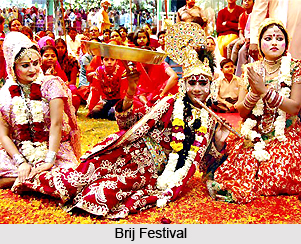 The Indian census of 2001 reads that the total population of Bharatpur district in Rajasthan, is 2, 04,560. Of this the percentage of males and females are 54 and 46 respectively and 15% of the population is below the age of 6years. The average literacy rate of Bharatpur is 66%, which is higher than the national average of 59.5%. The male literacy rate is much higher than the female literacy rate. Bhusawar serves both as a city and a municipality in Bharatpur district. The Jats and the Gujjars are the main agricultural communities which constitute the population of Bharatpur district. The region also comprises aboriginal people like the Banjaras, who are mainly artisans and tradesmen and live a nomadic life; the Minas (Mewatis) and the Gadia Lohars. The latter are another wandering tribe, who are engaged in the occupation of repairing household agricultural and implements.
The Indian census of 2001 reads that the total population of Bharatpur district in Rajasthan, is 2, 04,560. Of this the percentage of males and females are 54 and 46 respectively and 15% of the population is below the age of 6years. The average literacy rate of Bharatpur is 66%, which is higher than the national average of 59.5%. The male literacy rate is much higher than the female literacy rate. Bhusawar serves both as a city and a municipality in Bharatpur district. The Jats and the Gujjars are the main agricultural communities which constitute the population of Bharatpur district. The region also comprises aboriginal people like the Banjaras, who are mainly artisans and tradesmen and live a nomadic life; the Minas (Mewatis) and the Gadia Lohars. The latter are another wandering tribe, who are engaged in the occupation of repairing household agricultural and implements.
The Jats have been the main inhabitants of the district of Bharatpur since their win over the Mughals in the late 17th century. The Jats represent a type, which is close to the traditional Aryan colonists of India. Their stature is usually tall, complexion fair, eyes dark, with plentiful of facial hair, a long head and a prominent nose. The Jat is still in the tribal stage of social evolution, knowing no rigid caste distinction. The language in this north eastern part of Rajasthan is predominantly Mewati, and Hindi is used as the official state language. English is also a commonly spoken language. The most popular religion that is practiced in the district of Bharatpur is Hinduism and it involves the worship of Lord Shiva , Lord Vishnu, Brahma and other gods and goddesses. The important religious centre for the Lord Krishna followers is Nathdwara. Arya Samaj has also attracted many followers with its reformed view on modern Hinduism. Jainism has recently gained popularity among the higher echelon of society. Islam ranks second to Hinduism and there has also been a considerable increase in the numbers of followers of Sikhism .
The culture of Bharatpur is quite fascinating. Men wear colourful clothes and women prefer heavy jewelleries. The festivals are celebrated with great pomp and show. The Brij festival is scheduled a few days before Holi and is celebrated in honour of lord Krishna. The villagers marked in hued clothes are seen performing the Raslila, a dance which celebrates the immortal love story of Radha and Krishna. On the eve of holi, the whole of Bharatpur comes to life all over again in the sound of folk melodies. Everyone including the young and old, rich and poor, grace the occasion with their lively participation. They take delight in splashing colours on each other. It is also a period of fun and frolic for the villagers and gives them a respite from their busy lives. Even the animals are decorated with great care. Besides this at Pushkar fair the piercing of camel"s nose is an important ritual. Camel race and camel beauty contests are spectacles to behold. It is believed that during this fair at Pushkar, all the gods visit here and bless the devotee.
People in the Bharatpur district are free to follow occupation of their choice, irrespective of their caste. The Jats mainly depend on agriculture for their livelihood. Due to scarcity of rainfall the growth of vegetables is not very favourable and so there is an increase in the cultivation of pulses, mainly, moong, moth and gram. Bharatpur district is well known for oil industries which provide employment to the people. There are 50 major oil industrial units in Bharatpur district. Minerals like silica sand, sand stone and masonry stone yield a huge income and contribute to the economy. The people of Bharatpur are known for their experimentation with food. The ethnic cuisine involves use of ghee in cooking. Dalia, which is prepared with broken wheat sautéed in ghee and sweetened, is a popular dish in this region. The dressing habits of the people of Bharatpur district is greatly influenced by the climate, economic status, and profession. The Hindu men wear traditional dresses like dhoti, dhabla, banda and khol and for the women it is saris, lehenga choli with a dupatta or patka. Muslim men and women wear achkans and burkhas respectively.






